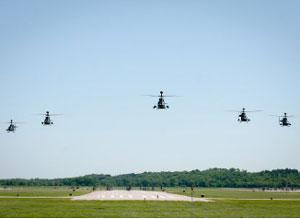
The Fayetteville-Fort Bragg community paid its respects to the men and women of the 1st Squadron, 17th Cavalry Regiment during a fly over at the Airborne and Special Operations Museum. The Fort Bragg-based squadron is the last on duty in the United States. The squadron and its 30 helicopters have been reassigned to South Korea. The OH-58D Kiowa Warrior primarily operates as an armed reconnaissance aircraft in support of ground troops. Except for the one remaining squadron, the Bell Kiowa is being replaced by the Boeing AH-64 Apache Attack Helicopter. The final flight from Simmons Army Airfield to Fayetteville and back was the community’s way of saying thank you for the service and farewell.
The Kiowa Warrior helicopter has played a key scouting role for decades. The Bell OH-58 Kiowa is a family of single-engine, single-rotor helicopters used for observation, utility and direct fire support. Bell manufactured the OH-58 for the Army based on its civilian Jet Ranger aircraft. The OH-58 has been in continuous use by the U.S. Army since 1969. The latest model, the OH-58D Kiowa Warrior, is primarily operated as an armed reconnaissance aircraft in support of ground troops. It is used worldwide having been exported to Austria, Canada, the Dominican Republic, Taiwan and Saudi Arabia.
The 17th Cavalry is an historical organization that began as a regiment of cavalry following the Poncho Villa Expedition. The unit was constituted in July 1916 in the Regular Army as the 17th Cavalry at Fort Bliss, Texas, and originally inactivated in September 1921. Then, it was reorganized as a part of the Army’s Regimental System in an ongoing effort to maintain the lineage and history of the Army. In early spring 2006, 1st Squadron, 17th Cavalry, transferred to Fort Campbell, Kentucky, and was reflagged as the 7th Squadron, 17th Cavalry of the 101st Airborne Division (Air Assault). As part of the Army’s modular force structure, the 1st Squadron was reassigned to the 82nd Airborne Division’s reorganized 82nd CAB. This summer, the squadron departs Fort Bragg for Korea.
When the unit was reactivated and assigned to the 82nd CAB. The formation included: Headquarters and Headquarters Company (Gryphon), 1st Squadron, 17th Cavalry Regiment (Saber), 1st Attack Reconnaissance Battalion (Wolfpack), 2nd Assault Battalion (Corsair), 3rd General Support Aviation Battalion (Talon), and 122nd Aviation Support Battalion (Atlas). When Saber’s nine-month deployment to South Korea is completed next year, the unit will switch to more modern Apache helicopters and unmanned aerial vehicles (drones).
Air cavalry soldiers are sometimes seen wearing traditional Stetson headgear. It was the headgear of Cavalrymen during the late 18th century into the 19th century, including the Indian Wars, Civil War and Mexican-American War. In the modern Army, the Stetson was revived as an unauthorized, unofficial headgear for the sake of esprit de corps. Because it is not authorized, wear and use
of the Stetson is regulated by
unit commanders.